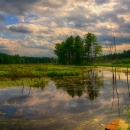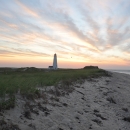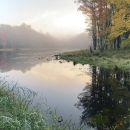About Us
Nomans Land Island is located in Dukes County, Massachusetts, three miles southwest of Martha’s Vineyard. This island has a unique history. Historically, the Cape and Islands were home to the Wampanoag Tribe. Ancestors of the federally recognized Wampanoag Tribe of Gay Head (Aquinnah) used the island perhaps as early as the Late Archaic Period (5,000 years before present). The island also had sheep grazing when the island was privately owned in the 1800’s, to then being used as a bombing range by the U.S. Navy starting during World War II. Portions of the island have been managed by the Service since 1970, while the island was still owned by the U.S. Navy. The Navy transferred ownership of the island to the Service in 1998. therefore, establishing the refuge. This refuge is closed to all public uses.
Nomans Land Island provides diverse habitats including intertidal, freshwater wetland, grassland, and shrubland habitats. It serves an important role for nesting colonial waterbirds, and as a stopover for migratory birds. Species that inhabit the 628-acre island include, seabirds such as double crested cormorants and common terns, waterfowl, marsh bird, shorebirds, songbirds, raptors, reptiles such as the spotted turtle, mammals, including the New England cottontail and insects, such as the monarch butterfly.
Our Mission
Vision
We envision Nomans Land Island NWR to be a vital and unique maritime resource for migratory birds along the Atlantic Flyway. Our management will perpetuate the diversity of nesting, resting, and foraging habitats used by passerines, raptors, waterfowl and seabirds throughout the island. In particular, species of regional conservation concern including the peregrine falcon will benefit from land which is free from mammalian predators and from present-day human disturbances.
Nomans Land Island has a culturally rich human history that began thousands of years ago and our management will ensure that this legacy endures. Culturally sensitive management actions on the island, and strong partnerships with the Wampanoag Tribe of Gay Head (Aquinnah) and other partners, will foster cultural awareness and an appreciative and knowledgeable public.
With its recent history of human use, Nomans Land Island NWR will be a place few people can experience firsthand; yet we will provide meaningful alternatives for members of the public to experience the beauty and singularity of the Refuge. Through partnerships, education, interpretation and outreach, we hope to instill a sense of wonder about complex and dynamic coastal ecosystems, and underscore the value of the Refuge in conserving those resources.
Refuge Purpose(s)
Each unit of the National Wildlife Refuge System is established to serve a statutory purpose that targets the conservation of native species dependent on its lands and waters. All activities on those acres are reviewed for compatibility with this statutory purpose.
The purpose(s) of this unit is. . .
for use as an inviolate sanctuary, or for any other management purpose, for migratory birds." 16 U.S.C
Our History
- The Early Archaic Period (9,000 to 7,000 BP): Archaeological sites found in southeastern Massachusetts. The Wampanoag Tribe has inhabited southeastern Massachusetts, the Cape, and Islands for over 12,000 years. Check out more history on the Wampanoag Tribe here and the Ancient Ways of the Wampanoag Tribe here.
- 1975: U.S. Fish and Wildlife Service began managing the eastern 1/3 of island as a refuge under joint Wildlife Management Agreement with the U.S. Navy, while still under Navy ownership.
- 1996: Range operation ended, and preparation began for the island to be turned over to U.S. Fish and Wildlife Service for a National Wildlife Refuge.
- 1998: U.S. Fish and Wildlife Service began exclusive use of the island under Federal-Federal transfer of property; establishment of Nomans Land Island National Wildlife Refuge.
Other Facilities in this Complex
Situated along the Atlantic Flyway in Massachusetts, the Eastern Massachusetts National Wildlife Refuge Complex is comprised of eight ecologically diverse refuges. The eight individual refuges include inland and coastal wetlands, forests, grasslands, and barrier beaches that provide important habitat for migratory birds, mammals, plants, reptiles and amphibians.
Complex headquarters is located at Assabet River National Wildlife Refuge, 680 Hudson Road, Sudbury, MA, 01776. Phone: (978) 443-4661.



